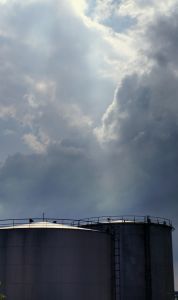US To Fund 7 Carbon Sequestration Tests Aimed At Cutting Emissions

The U.S. Department of Energy (DOE) says it will fund $450 million over the next 10 years to support seven tests in the United States designed to advance carbon sequestration technologies.
Assistant Secretary Jeffrey D. Jarrett discussed the effort while attending the Asia-Pacific Partnership on Clean Development and Climate. The studies are designed to validate whether the large scale capture, transportation, injection, and long term storage of carbon dioxide (CO2) can be done safely, permanently, and economically.
Gases like CO2 are blamed for global climate change.
"Carbon sequestration will play a key role in the United States' effort to mitigate climate change and holds the key to the continued environmentally-responsible use of coal," Jarrett said. "These tests, the next step in demonstrating that sequestration technologies are ready for commercialization, will help us achieve the President’s climate change initiative by confirming that the geology of North America is suitable for the permanent and safe storage of CO2 for millennia."
The Asia-Pacific Partnership on Clean Development and Climate is a unique public-private initiative among government and private sector partners from Australia, China, India, Japan, the Republic of Korea and the United States. These six countries account for about half of the world’s population and more than half of the world's economy and energy use. The First Ministerial meeting of the Asia-Pacific Partnership took place in Sydney, Australia, in January 2006. At that meeting, the ministers agreed to a Partnership Communique, Charter, and Work Plan that established eight public-private sector Task Forces.
Carbon sequestration technology has been successfully accomplished during smaller scale demonstration projects, according to the Energy Department. If successful on a large scale, it could play a significant role in reducing greenhouse gas emissions intensity by 18 percent by 2012 and ensure that sequestration technologies will be ready for broad use in the near future, the department says.
As part of this effort, DOE will work with the existing Regional Carbon Sequestration Partnerships to develop these large volume sequestration tests. The partnerships have already been working to characterize their regions’ opportunities and existing infrastructure for carbon sequestration.
Results obtained from the tests will be crucial to the development of DOE's FutureGen power plant, which will produce both hydrogen and electricity from a highly efficient and technologically sophisticated coal-fired power plant, and do so with virtually no emissions. The geologic structures that will be tested during these large volume sequestration tests could be candidate sites for FutureGen like plants.
The Partnerships have preliminarily identified sequestration opportunities across the United States and estimate that they have the potential to store more than 600 billion metric tons of CO2, the equivalent of more than 200 years of emissions from energy sources in the United States. They are currently implementing a number of small field tests designed to validate the estimates.


0 Comments:
Post a Comment
Subscribe to Post Comments [Atom]
<< Home